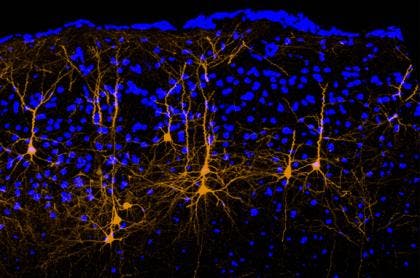Every time we’re engaged in a certain action, the sounds we produce while walking, eating, even playing music are tuned down a notch in volume by the brain. For instance, during a conversation your voice will be perceived as quieter than it actually is in reality, since our brain want to receive clearer the information relayed by the other person. This mechanism is a very important function of the brain, since this distinguishing between the sounds we make and those coming from our environment is paramount to anything from learning how to speak, to survival (is that sound made by me or some predator lurking in the dark?). Recently, scientists at Duke University made a big breakthrough after they uncovered the brain circuitry that governs this ability of the brain. The findings are important since they might help in the future explain how a malfunction in this motor-auditory system interplay causes psychotic diseases, like schizophrenia.
“Our finding is important because it provides the blueprint for understanding how the brain communicates with itself, and how that communication can break down to cause disease,” said Richard Mooney, Ph.D., senior author of the study and professor of neurobiology at Duke University School of Medicine. “Normally, motor regions would warn auditory regions that they are making a command to speak, so be prepared for a sound. But in psychosis, you can no longer distinguish between the activity in your motor system and somebody else’s, and you think the sounds coming from within your own brain are external.”

For a long time, the researchers hypothesized that the same neuronal circuitry used to convey movement (stroke a piano key, pick up an item etc) is shared by the wiring that senses sound. The exact nerve cells that provide this function, however, remained unknown until recently. Mooney and colleagues used a Duke University patented technology to trace all of the inputs into the auditory cortex — the sound-interpreting region of the brain. A number of regions of the brain feed information into the auditory cortex, but the researchers focused their attention on the secondary motor cortex (M2), responsible for relaying motor signals directly into the brain stem and spinal cord.
“That suggests these neurons are providing a copy of the motor command directly to the auditory system,” said David M. Schneider, Ph.D., co-lead author of the study and a postdoctoral fellow in Mooney’s lab. “In other words,they send a signal that says ‘move’ but they also send a signal to the auditory system saying ‘I am going to move.'”
The brain, sick of hearing itself all the time
It’s basically prepping the brain that the body is going to perform an action, in order to distinguish between sounds. To better understand how this connection works, the researchers cut slices of mice brain and specifically manipulated the neurons that led from the M2 region to the auditory cortex. Stimulating neurons from this specific regions dampened the activity of the auditory cortex.
“It jibed nicely with our expectations,” said Anders Nelson, co-lead author of the study and a graduate student in Mooney’s lab. “It is the brain’s way of muting or suppressing the sounds that come from our own actions.”
Finally, the researchers tested this circuitry in live animals, artificially turning on the motor neurons in anesthetized mice and then looking to see how the auditory cortex responded. Mice usually sing to each other through a kind of song called ultrasonic vocalizations, which are too high-pitched for a human to hear. The researchers played back these ultrasonic vocalizations to the mice after they had activated the motor cortex and found that the neurons became much less responsive to the sounds.
“It appears that the functional role that these neurons play on hearing is they make sounds we generate seem quieter,” said Mooney. “The question we now want to know is if this is the mechanism that is being used when an animal is actually moving. That is the missing link, and the subject of our ongoing experiments.”
These preliminary findings have uncovered only the basic interplay between the motor and auditory cortex. The next step in the researchers’ work is testing whether altering this circuitry could induce auditory hallucinations or perhaps even take them away in models of schizophrenia.
Findings appeared in The Journal of Neuroscience.






